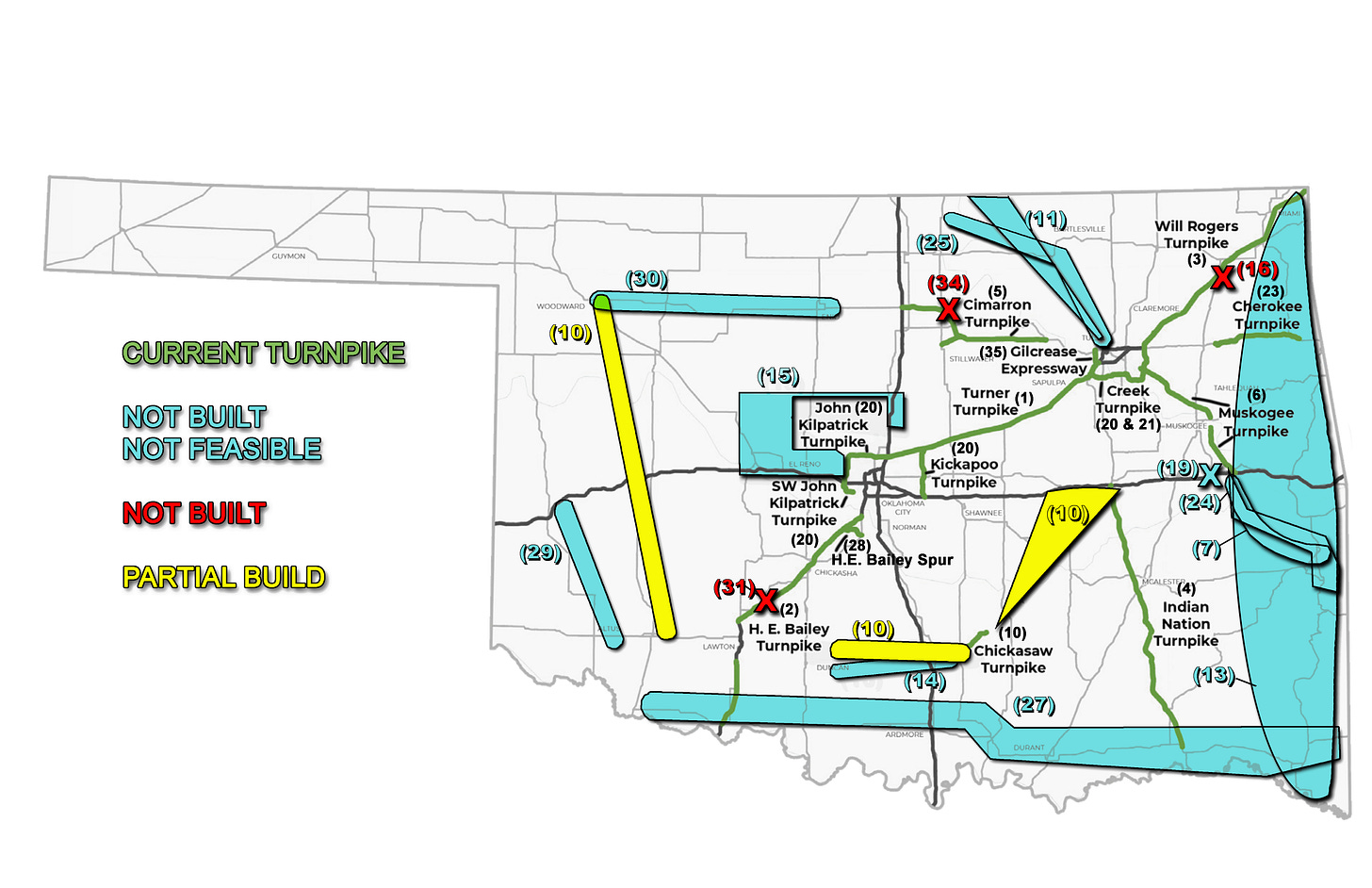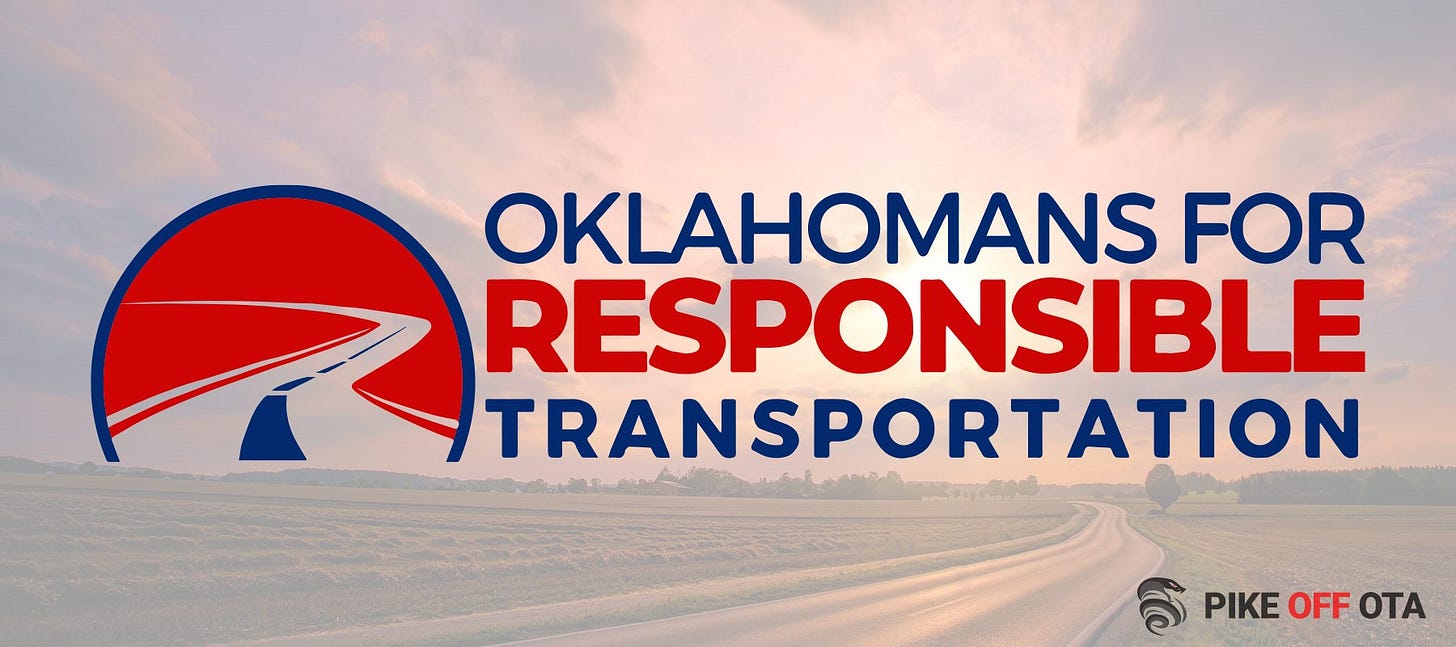How many unauthorized (illegal) projects does the ACCESS Program contain?
Proposed Interchanges along H.E.Bailey and Indian Nation Turnpike aren't specifically authorized in statute - is that a problem?
So many interesting revelations have come out of that July 27, 2022 email from the OTA to the Governor’s Office. Make sure you check out the all the previous posts discussing the open record request documents.
The email listed all of the Oklahoma Turnpike routes authorized in state statute in Title 69, Section 1705(e) and color coded each of the thirty five authorizations as “yellow = turnpike or exit fully/partially built,” and “blue = turnpike not built/equivalent ODOT route.” The thirty-five separate authorizations were also annotated with explanations.
Oklahomans for Responsible Transportation took these thirty-five OTA annotated authorizations provided in the open record request email from July 27, 2022 and mapped them accordingly.
In the previous post, we talked about the GREEN, BLUE and YELLOW areas on the map. All of the statute descriptions and added email notations and color coding are located in that post.
Now, let’s talk about the red X’s.
The three interchanges along existing turnpike routes shown in RED (#16, #31, #34) were annotated as “unbuilt interchange” by the OTA. Location #16 authorization is along the Will Rogers and is not planned to be built in the ACCESS program, according to their currently posted list (below). Location #34, a new interchange at SH-108 near Glencoe along the Cimarron Turnpike, is one of the planned interchange projects on the ACCESS OKLAHOMA website (1st one listed).
H.E. Bailey Turnpike Proposed New Interchanges NOT in Statute
Location #31 is along the H.E. Bailey at the US 277 intersection near Fletcher (shown in green on the map). If you look at the list of proposed ACCESS interchanges along the H.E. Bailey that are proposed to be built and find them on the map below, you will see that the one called out as #31 in the statute will not be built, but three more new interchanges that are NOT authorized in statute (shown in red) are proposed. The interchange shown in yellow is an upgrade to an existing interchange.
Why did the ACCESS program not include the #31 on its list to be built and how can they include three locations that are not specifically called to in statute?
Indian Nation Turnpike Proposed New Interchanges NOT in Statute
ACCESS Oklahoma contains four proposed interchange locations along the Indian Nations Turnpike. Two of these are upgrades to existing interchanges (shown in yellow) and two of these are new proposed interchange locations not specifically contained in statute (shown in red).
It is unclear why some interchange locations are called out in statute (e.g.,#16, #31, #34), while other new interchanges being proposed to be constructed within the ACCESS program along the HE Bailey and Indian Nation Turnpikes are not specifically authorized in statute.
Is it required by statute to call out each individual interchange location along an existing turnpike?
Is it legal to build a new interchange without first seeking legislative authorization?
Has the presence (or absence) of interchange locations in statute been enforced previously?
I feel like we need to know when the last brand new interchange on an existing turnpike was built and if it was specifically called out in statute. If that did occur, it probably would have been constructed sometime between 1991 and 2017. The evolving location authorizations over the past 70 years and the lack of transparency within the OTA makes this difficult to track.
Does the OTA have discretion to construct interchanges along existing turnpikes at locations they deem to have the highest need (or where their business associates deem it necessary)? If so, why would individual interchange locations be included in statute?
It is frustrating that the turnpike enabling act is inconsistently interpreted, ambiguous and purposely vague. The OTA’s typical, “we’ve always done it this way” business practices routinely run contrary to both the enabling act and their master trust agreement and legislative intent becomes lost over the decades that these locations sit in statute.
WE MUST TAKE ACTION: Title 69, Section 1705(e) MUST be clarified and modernized.
It is not good policy to have locations of interchanges, turnpikes and bridges sitting unbuilt in statute for 40+ years that creates confusion and ambiguity about which authorization corresponds to which turnpike location. There is obviously also inconsistency in seeking specific location authorizations for certain interchanges along existing routes and not others.
It was obvious with the legal fight concerning the East-West Connector and South Extension proposed routes that the OTA was able to utilize the ambiguity and inconsistency within the turnpike enabling act to their advantage. In our case, we had a Supreme Court completely throw out legislative intent and DOUBLE COUNT one specific location authorization as TWO completely different turnpikes (see this post). That is not how the enabling act is supposed to work.
What OTHER location authorization within the list of 35 has been interpreted to describe TWO DIFFERENT TURNPIKES in TWO DIFFERENT LOCATIONS?
Location Authorization #28 cannot possibly describe BOTH the H.E. Bailey Spur & the South Extension at the same time. It doesn’t take a rocket scientist to understand that; just an intellectually dishonest Supreme Court majority.
To avoid the kind of disastrous misinterpretation of the statutes that we recently endured, we need to sunset all location authorizations that have not been built and provide historical references for the remaining location authorizations. We should explicitly define the tollroad built with the corresponding location authorization and enshrine in the law the year they were authorized and were finished so that legislators, citizens and members of the judiciary can easily understand what is going on; and to keep the OTA honest. We also need to have a legal opinion on whether or not specific interchanges along existing tollroads need to be called out in statute or if the OTA has “carte blanche” to build wherever and whenever they want.
Help us enact legislative reform and join our grassroots advocacy team!
Watch this awesome short video on Tollahoma
While you are pondering all the ways in which the Turnpike Enabling Act needs to be reworked, watch this short video explaining why Oklahoma has so many tollroads, and what makes a tollroad useful. Spoiler: we have a TON of worthless tollroads that connect “nowhere to nowhere.”
Tollahoma: “With this system of bondholders and profit being the motivator behind building the turnpikes , rather than the actual mobility of the people of Oklahoma, it behooves the OTA and its bondholders to continue building as many turnpikes as possible to keep that money flowing. When the debt of these roads is close to being paid off, new bonds are issued and new roads are constructed. This is why you currently see some tollroads in the state that seemingly connect farmland with grass and hills. Nowhere to nowhere. Oklahoma doesn’t really have that many population centers but somehow has all of these roads.”
Stay tuned for the next post!
Make sure you SUBSCRIBE to this Substack to get notified when a new post drops. Thank you for your support! We can continue to fight only if our community supports us.
PIKE OFF OTA (501 c4) and Oklahomans for Responsible Transportation, Foundation (501 c3) are leading the charge in legal injunctive avenues and legislative reform and they could use your help. They are trying to dismantle a corrupt Goliath within our state and are doing a great job. Be part of the solution!
www.pikeoffota.com
Join us on Facebook as well.









